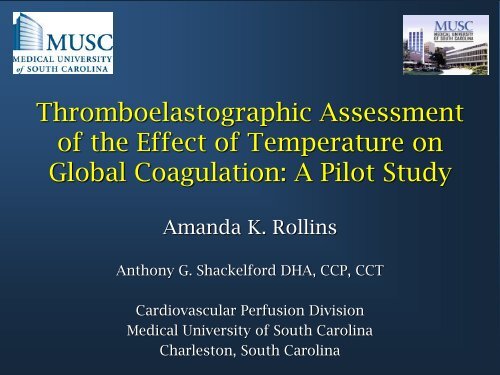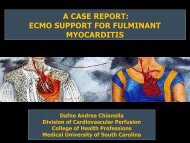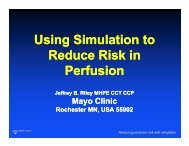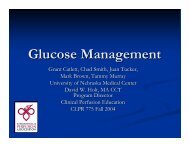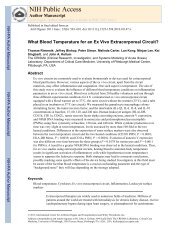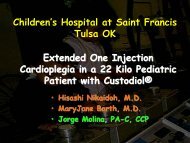PowerPoint Presentation (PDF) - Perfusion.com
PowerPoint Presentation (PDF) - Perfusion.com
PowerPoint Presentation (PDF) - Perfusion.com
You also want an ePaper? Increase the reach of your titles
YUMPU automatically turns print PDFs into web optimized ePapers that Google loves.
Thromboelastographic Assessment<br />
of the Effect of Temperature on<br />
Global Coagulation: A Pilot Study<br />
Amanda K. Rollins<br />
Anthony G. Shackelford DHA, CCP, CCT<br />
Cardiovascular <strong>Perfusion</strong> Division<br />
Medical University of South Carolina<br />
Charleston, South Carolina
Background: Neurologic Injury<br />
In Open Heart Surgery<br />
• Prevention:<br />
• Using systemic hypothermia (SH) during<br />
cardiopulmonary bypass (CPB)<br />
• causes a reduction in oxygen consumption and results in<br />
an increased neuroprotective effect.<br />
• SH does <strong>com</strong>e with other risks<br />
2
Effects of Hypothermia<br />
and Rewarming<br />
Hypothermia<br />
• Decrease metabolism<br />
and oxygen demand<br />
• Decreases chance for<br />
ischemic injury in<br />
tissues<br />
• Delays the coagulation<br />
cascade and causes<br />
decreasing platelet<br />
function.<br />
• Requires the patient to<br />
be rewarmed.<br />
Rewarming<br />
• Historical strategies<br />
heat the body back to<br />
37°C while causing the<br />
brain to be effectively<br />
warmed to 38 or 39°C.<br />
• The brain rewarms<br />
faster than other<br />
tissues of the body.<br />
• Increased temperatures<br />
can contribute to<br />
neurologic injury.
Hypothermia Paradox<br />
Neurologic Injury<br />
↑ Brain Temperatures<br />
↑ CPB Times<br />
↑ GME<br />
Employ<br />
Hypothermia<br />
> 37°C Arterial<br />
Blood<br />
Temperatures<br />
Employ<br />
Rewarming<br />
4
Balancing the Pros and Cons<br />
Hypothermia<br />
↓ Hemostasis ?<br />
Normothermia<br />
↑ Neurological Injury
Conflicting Evidence<br />
• Bleeding study<br />
• Hypothermia<br />
induces platelet<br />
inhibition.<br />
• Platelet function<br />
normal when<br />
restored to 37°C.<br />
• Fundamental Paper<br />
for normothermic<br />
practice today<br />
Valeri CR, Feingold H, Cassidy G, Ragno G, Khuri<br />
S, Altschule MD. Hypothermia-induced reversible<br />
platelet dysfunction. Ann Surg 1987;205:175-181.<br />
• Separated from CPB<br />
• as low as 34°C<br />
• no differences in<br />
blood loss<br />
• blood product use<br />
was similar between<br />
the groups<br />
Nathan HJ, Wells GA, Munson JL, Wozny D.<br />
Neuroprotective effect of mild hypothermia in<br />
patients undergoing coronary artery surgery with<br />
cardiopulmonary bypass: a randomized trial. 6<br />
Circulation 2001;104:I85-91.
Q: How much must the patient be<br />
rewarmed to achieve adequate<br />
coagulation?<br />
A: The answer is relatively unknown.<br />
Comment: Patients are returned to<br />
normothermia, but is this necessary?
Clinical Significance<br />
of this Study<br />
If hemostasis<br />
restored<br />
< 37°C<br />
•Terminate CPB at<br />
that temperature<br />
Brain not<br />
exposed to:<br />
•higher temperatures<br />
•longer CPB times<br />
(GME).<br />
Could contribute<br />
to a reduction in<br />
the incidence of<br />
neurologic<br />
injury.<br />
8
Background:<br />
Thromboelastography (TEG)<br />
• Point of Care test<br />
• results
TEG Variables<br />
R Time<br />
K-Time and Alpha angle<br />
MA – (Maximum Amplitude)
Hypotheses<br />
• H 0 : It is feasible to use the Thromboelastogram<br />
(TEG) to answer research questions involving<br />
the effect of temperature on global coagulation.<br />
• H 1 : There is no difference in measured TEG<br />
parameters at temperatures of 33°C – 37°C
Methods<br />
12
Verification of Proper<br />
Temperature Manipulation<br />
13
Experimental<br />
Method<br />
TEG WELL 1:<br />
37°C<br />
Citrated<br />
Blood Sample<br />
Kaolin +<br />
CaCl 2<br />
TEG WELL 2:<br />
Experimental<br />
Temp<br />
TEG WELL 3:<br />
37°C<br />
Averages of the various TEG parameters from the<br />
2 experimental temperatures wells for each trial<br />
will be <strong>com</strong>pared to the averages of the normal<br />
temperature TEG parameters.<br />
TEG WELL 4:<br />
Experimental<br />
Temp
Results<br />
R values<br />
Trial 33 Trial 34 Trial 35 Trial 36<br />
37 6.75 8.2 9.6 8.4<br />
temp 7.35 8.85 9.85 8.15<br />
12<br />
10<br />
8<br />
6<br />
4<br />
2<br />
R-Values<br />
percent<br />
change -8% -8% -3% 3%<br />
37<br />
Temp<br />
0<br />
Trial 33 Trial 34 Trial 35 Trial 36
Results<br />
K Values<br />
Trial 33 Trial 34 Trial 35 Trial 36<br />
37 1.75 2.65 2.5 2.25<br />
temp 2.05 2.3 2.55 2.1<br />
percent<br />
change -17% 13% -2% 7%<br />
3<br />
K-Values<br />
2.5<br />
2<br />
1.5<br />
1<br />
37<br />
Temp<br />
0.5<br />
0<br />
Trial 33 Trial 34 Trial 35 Trial 36
Results<br />
MA Values<br />
Trial 33 Trial 34 Trial 35 Trial 36<br />
37 57.45 61.65 63.7 63.7<br />
Temp 61.25 63.05 64.05 61.55<br />
MA Values<br />
percent<br />
change -7% -2% -0.60% 3%<br />
68<br />
66<br />
64<br />
62<br />
60<br />
58<br />
56<br />
54<br />
52<br />
50<br />
Trial 33 Trial 34 Trial 35 Trial 36<br />
37<br />
Temp
Results<br />
LY30<br />
Trial 33 Trial 34 Trial 35 Trial 36<br />
37 1.05 0.25 0.1 0.15<br />
Temp 0.05 0 0 0.35<br />
Percent<br />
Change -95% -100% -100% 133%<br />
1.2<br />
LY30<br />
1<br />
0.8<br />
0.6<br />
0.4<br />
37<br />
Temp<br />
0.2<br />
0<br />
Trial 33 Trial 34 Trial 35 Trial 36
Conclusion<br />
• As a pilot study, significance could not<br />
be declared statistically due to the<br />
sample size. However, the data<br />
suggests that there may be a<br />
temperature below 37°C at which<br />
adequate coagulation is restored.<br />
• Neurologic deficits may be avoided by<br />
not rewarming to such extreme<br />
temperatures.
Limitations of the Study<br />
• Sample size<br />
• Age of the blood<br />
• Mechanical disparities
Future Research<br />
• A study modeled after the methods<br />
used in this pilot study. This study<br />
will involve a large number of subjects<br />
that will be undergoing CPB.
TEG At 37°C<br />
TEG At 34°C<br />
22
Thank you for this<br />
opportunity!<br />
Questions?


